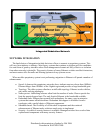SUMMARY
The open standard networks support multiple topologies over Ethernet at speeds of 100Mbit/s or
better and provide TCP and UDP interfaces. This should make clear the evolution to high speed
Ethernet over a variety of topologies.
INDUSTRIAL ETHERNET
Industrial Ethernet supports the integration of existing sub-networks into a homogeneous network
that includes effective routing, redundant links, and beefed up security. Many Ethernet vendors offer
products designed for industrial environments. Ethernet hubs, managed and un-managed switches,
media converters, and edge switches, hardened for hostile environments, are available at speeds up to
the Gigabit range and operational over a variety of topologies using coax, copper, and fiber. Since
many industrial networks already support Ethernet, integration is often straightforward.
Software is usually GUI-based to more effectively manage, configure, and monitor industrial
networks. Ethernet managed and un-managed switches, including edge switches, coupled with the
right topology provide the best solution to the control and support of remote sites such as power sub-
stations and unattended sites.
Industrial Ethernet networking has inherent advantages. By utilizing a standards-based solution that
supports multi-vendor implementations, industrial Ethernet users enjoy highly reliable systems with
rapid recovery, reduced costs of deployment, and a guaranteed upgrade strategy as needs evolve.
Redundancy and self-healing Ethernet networks provide the desired 24/7 uptime.
One other advantage of Ethernet is Power over Ethernet (PoE), which can greatly simplify the
wiring of the many sensors, monitors, and input devices found in industrial Ethernet environments.
The illustration below depicts an integrated substation network which interconnects substations and
central operations systems. Numerous Intelligent Electronic Devices (IEDs) such as relays, sensors,
meters and Remote Terminal Units (RTUs), as well as surveillance cameras, VOIP phones and other
devices are connected in a substation Local Area Network (LAN). Serial protocol devices are
connected via routers or terminal servers, and Ethernet devices, including Power-over-Ethernet-
enabled video cameras, are directly connected to Ethernet switches. The substation LAN connects to a
Wide Area Network (WAN) router to transmit data to central operations systems and centers for
processing and storage.
Distributed with permission of author by ISA 2006
Presented at ISA EXPO 2006












